Giovanni Battista Moroni (1520 – 1578)
Get a Moroni Certificate of Authenticity for your painting (COA) for your Moroni drawing.
For all your Moroni artworks you need a Certificate of Authenticity (COA) in order to sell, to insure or to donate for a tax deduction.
Getting a Moroni Certificate of Authenticity (COA) is easy. Just send us photos and dimensions and tell us what you know about the origin or history of your Moroni painting or drawing.
If you want to sell your Moroni painting or drawing use our selling services. We offer Moroni selling help, selling advice, private treaty sales and full brokerage.
We have been authenticating Moroni and issuing certificates of authenticity since 2002. We are recognized Moroni experts and Moroni certified appraisers. We issue COAs and appraisals for all Moroni artworks.
Our Moroni paintings and drawings authentications are accepted and respected worldwide.
Each COA is backed by in-depth research and analysis authentication reports.
The Moroni certificates of authenticity we issue are based on solid, reliable and fully referenced art investigations, authentication research, analytical work and forensic studies.
We are available to examine your Moroni painting or drawing anywhere in the world.
You will generally receive your certificates of authenticity and authentication report within two weeks. Some complicated cases with difficult to research Moroni paintings or drawings take longer.
Our clients include Moroni collectors, investors, tax authorities, insurance adjusters, appraisers, valuers, auctioneers, Federal agencies and many law firms.
We perform Giovanni Moroni art authentication, appraisal, certificates of authenticity (COA), analysis, research, scientific tests, full art authentications. We will help you sell your Giovanni Moroni or we will sell it for you.

Giovanni Moroni was an Italian mannerist painter, son of an architect, Andrea Moroni, born in Albino near Bergamo. He is also called Giambattista Moroni. Moroni was one of the great portrait painters of the sixteenth century. He trained under Alessandro Bonvicino in Brescia and worked mainly in and around his home town of Albino. He spent two short periods spent in Trento (1548 and 1551), at a time when the Council of Trent was in session. On both occasions Moroni painted a number of works (including the Altarpiece of the Doctors of the Church for the church of Santa Maria Maggiore).
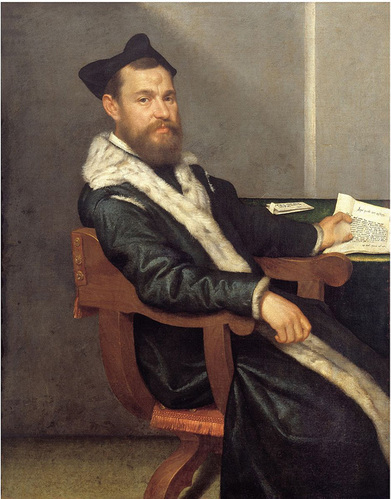
It was during his stay in Trento that he also made contact with Titian and the Madruzzo family. There are claims he was trained by Titian, however, it is improbable he ever ventured to the Venetian’s studio for long, if at all. From the 1550s onwards, in fact, Moroni was often commissioned for portraits as a cheaper alternative to the busy Titian. This resulted in abundant patronage for portraits. His output was a series of portraits that, while not quite heroic, are full of dignified humanity and grounded in everyday life.
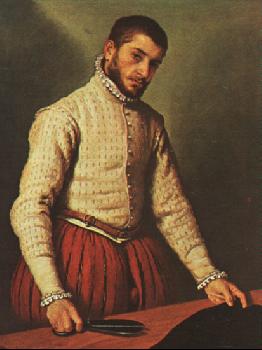
His output of religious paintings was smaller; for example, he painted an Ultima Cena (Last Supper) for the parish at Romano in Lombardy; Coronation of the Virgin in San Alessandro della Croce, Bergamo; also for the cathedral of Verona, SS Peter and Paul, and in the Brera of Milan, the Assumption of the Virgin. Moroni was engaged upon a Last Judgment in the church of Corlago (Colnago?), when he died. Overall, his style in these paintings shows influences of his master, Lorenzo Lotto, and Girolamo Savoldo. Giovanni Paolo Cavagna was an undistinguished pupil of Moroni; however, it is said that in following generations, his insightful portraiture influenced Fra’ Galgario and Pietro Longhi.

Freedberg notes that while his his religious canvases are “archaic” and show stilted unemotive saints, his portraits are remarkable for their sophisticated psychological insight, dignified air, and exquisite silvery tonality. Why was one category of his work is so limpid, and the other so expressive? One explanation is that the demands of the subject matter were different. Patrons for religious art were not interested in an individualized, expressive “Madonna”; they desired numinous archetypal saints. On the other hand, patrons were interested in the animated portraiture.
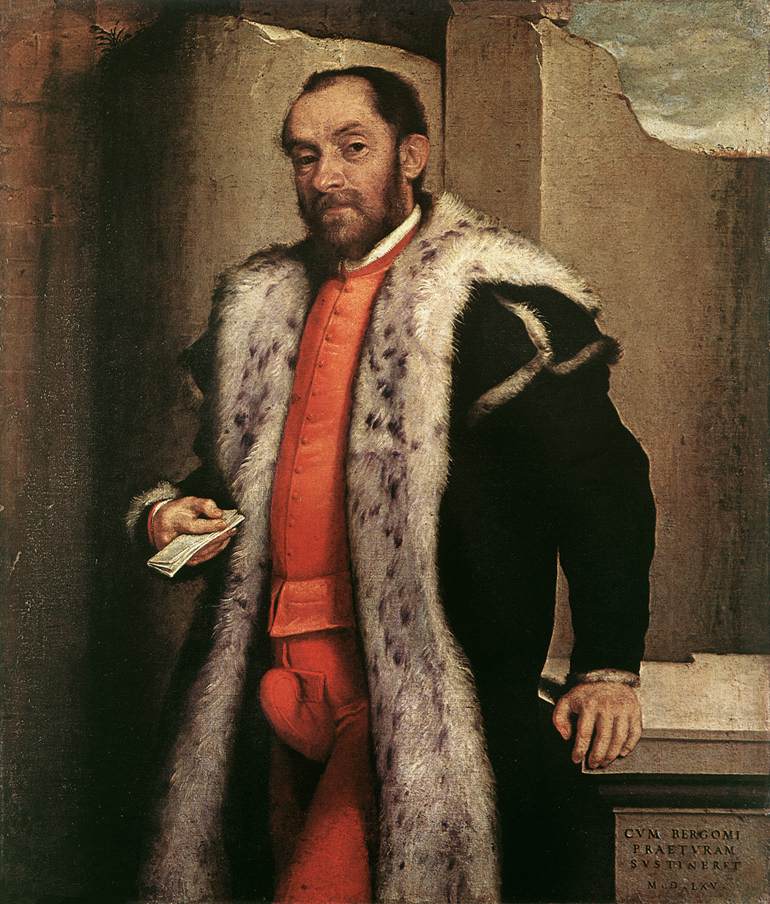
The National Gallery (London) has one of the best collections of his work, including the celebrated portrait known as “Il Sarto” (The Tailor) (a member of the Fenaroli family). Other portraits are found in the Uffizi, (the Nobleman pointing to Flame inscribed “Et quid volo nisi ut ardeat?”, Berlin Gallery,the Canon Ludovico de’ Terzi and Moroni’s own portrait; and in Stafford House, the seated half-figure of the Jesuit Ercole Tasso, currently termed “Titian’s Schoolmaster” (although there is no real connection).
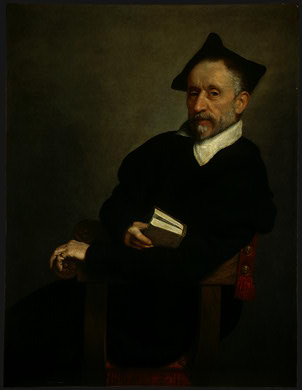
The Ashmolean Museum (University of Oxford), Brooks Museum of Art (Memphis, Tennessee), Detroit Institute of Arts, the Fine Arts Museums of San Francisco, the Hermitage Museum, the Honolulu Academy of Arts, Kunsthistorisches Museum (Vienna), the Liechtenstein Museum (Vienna), the Louvre, Musée Condé Chantilly (Chantilly, France), Museo Poldi Pezzoli (Milan), the Museum of Fine Arts, Boston, National Galleries of Scotland, the National Gallery of Art (Washington D.C.), the National Gallery of Australia, the National Gallery of Canada, the National Gallery, London, the Norton Simon Museum (Pasadena, California), Pinacoteca Ambrosiana (Milan), Pinacoteca di Brera (Milan), Rijksmuseum, the Ringling Museum of Art (Florida), Studio Esseci (Padua, Italy), University of Arizona Museum of Art, Virginia Museum of Fine Arts and the Uffizi are among the public collections holding works by Giovanni Battista Moroni.
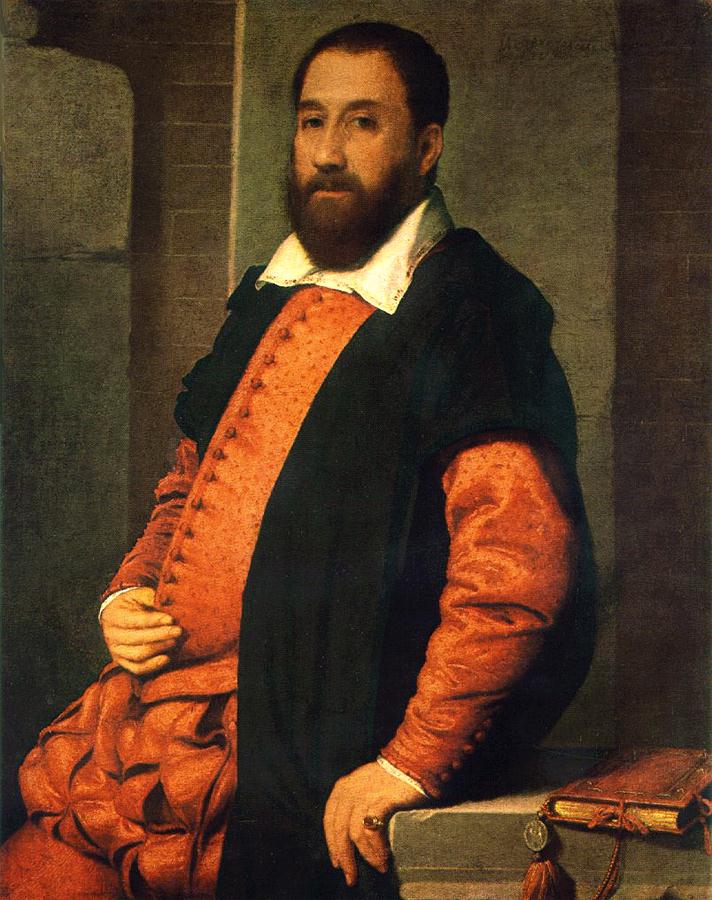
Still wondering about an Italian painting in your family collection? Contact us…it could be by Giovanni Moroni.
Reviews
1,217 global ratings
5 Star
4 Star
3 Star
2 Star
1 Star
Your evaluation is very important to us. Thank you.
